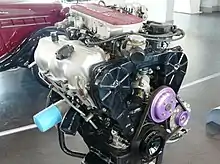Nissan VG engine
The VG engine family consists of V6 engines designed and produced by Nissan for several vehicles in the Nissan lineup. The VG series was introduced in 1983, becoming Nissan's and Japan's first mass-produced V6 engine. VG engines displace between 2.0 L and 3.3 L and featured an iron block and aluminum heads at a 60° vee-angle. The early VG engines featured a SOHC arrangement with 2 valves per cylinder. Later versions featured a slightly different block, a DOHC arrangement with 4 valves per cylinder, and N-VCT, Nissan's own version of variable valve timing, for a smoother idle and more torque at low to medium engine speeds. The production blocks and production head castings were used successfully in the Nissan GTP ZX-Turbo and NPT-90 race cars which won the IMSA GT Championship three years in a row.
| Nissan VG engine | |
|---|---|
.jpg.webp) VG30E engine in a 1987 300ZX GL | |
| Overview | |
| Manufacturer | Nissan (Nissan Machinery) |
| Production | 1983-2004 |
| Layout | |
| Configuration | 60° V6 |
| Displacement | 2.0 L; 121.9 cu in (1,998 cc) 3.0 L; 180.6 cu in (2,960 cc) 3.3 L; 199.9 cu in (3,275 cc) |
| Cylinder bore | 78 mm (3.07 in) 87 mm (3.43 in) 91.5 mm (3.60 in) |
| Piston stroke | 69.7 mm (2.74 in) 83 mm (3.27 in) |
| Block material | Cast iron |
| Head material | Aluminum |
| Valvetrain | SOHC, DOHC |
| Combustion | |
| Supercharger | Single Eaton Roots-type M62 (2001-2004 VG33ER) |
| Turbocharger | Single Garrett T3 (1983–1987 VG30ET; all VG30DET) Single Garrett T25 (1988-1989 VG30ET) Twin Garrett/Mitsubishi T22/TB02 (1989-2000 VG30DETT) |
| Chronology | |
| Predecessor | Nissan L engine (6-cylinder) |
| Successor | Nissan VQ engine |
Origins
Development of the VG series began in 1979 by Nissan Machinery, a former member of the Nissan Group keiretsu. The objective during development was to replace the Nissan L engine, an engine that was influenced by the Prince G engine, with an all-new V6 engine. The VG engine was fully designed by Nissan from scratch, and shared little mechanical components with its predecessor, or with another automaker's engine. Nissan engineers wanted the VG engine to have improved performance, fuel economy, reliability, and refinement, as well as being lighter and more compact than its predecessor. Extensive computer design techniques were used during development, which made the VG series one of the most advanced and high-tech engines of its day. It featured a sequential multi-port fuel injection system, and Nissan's Electronic Concentrated Control System (ECCS).
ECCS used a microprocessor and an oxygen sensor to control fuel delivery, spark timing, exhaust gas recirculation rate, and engine idle speed, depending on the current operating conditions of the engine. This system reduced carbon emissions, improved fuel economy, and improved engine performance during cold-start and warm-up conditions.
The advantages of the VG engine over its predecessor was that its V6 configuration would allow greater torsional rigidity for higher performance potential, and its shorter length would give Nissan designers and engineers more freedom for vehicle design, allowing them to design vehicles that had frontal crush zone space, and allowed transverse mounting.
All VG engines use a timing belt to synchronize the camshafts with the crankshaft, in comparison to the L engine, which uses a timing chain. Most VG engines use an interference design; in the event of a timing belt failure, The pistons will likely bend the valves, and can cause major engine damage. The VG series engine was put into thousands of Nissan vehicles, debuting in Japan in the 1983 Nissan Gloria/Nissan Cedric, and in the US and other markets in the 1984 Nissan 300ZX.
When the Nissan VQ engine was introduced in 1994, the VG engine was slowly phased out in Nissan cars, and after 2000 it was only available in the Nissan Frontier and Nissan Xterra. The VG engine was retired in 2004, by which time all V6-powered Nissans had switched to the VQ engine.
VG20E

The VG20E is a 1,998 cc (2.0 L) SOHC engine produced from 1984 on. It produces between 115 PS (85 kW; 113 hp) and 125 PS (92 kW; 123 hp) net. In the earlier gross rating system, early eighties' models claim 130 PS (96 kW; 128 hp).
Applications:
- 1983–1987 Nissan Gloria/Nissan Cedric Y30
- 1987–1999 Nissan Gloria/Nissan Cedric Wagon/Van Y30
- 1986-1988 Nissan Bluebird Maxima U11
- 1986-1992 Nissan Leopard F31
- 1987–2002 Nissan Gloria/Nissan Cedric Y31
- 1991–1995 Nissan Gloria/Nissan Cedric Y32
- 1996–2002 Nissan Gloria/Nissan Cedric Y33
- 1997-1999 Nissan Leopard JY33
VG20ET
The VG20ET was based on the VG20E, but with an added turbocharger. The VG20ET produces 170 hp (127 kW). This SOHC motor debuted at the same time as the VG20E. Also coming with the Y30, this motor was known as the "Jet Turbo", and came with the Nissan Leopard models XS, and XS-II Grand Selection. Contrary to the VG30ET that came out in the US, the VG20ET came with an intercooler in certain models to push the horsepower output to 155 hp (116 kW), a great jump from the normally aspirated VG20E. The turbo included with the VG20ET had two different settings. At low speeds, the turbo's wastegate would stay closed improving the response at low rpm. At high speeds, the flap would stay open, decreasing resistance and increasing exhaust flow. At its maximum flow, the flap would open at an angle of 27 degrees, while the A/R ranged from 0.21–0.77. Being that the VG20ET had a short stroke 78 mm × 69.7 mm (3.07 in × 2.74 in), it was thought to have insufficient low end torque. Nevertheless, the VG20ET was a great improvement over the VG20E.
Applications:
- 1984–1989 Nissan 200Z (Z31)
- 1984–1989 Nissan 200ZG (Z31)
- 1984–1989 Nissan 200ZS (Z31)
- 1984–1989 Nissan Laurel Medallist (C32)
- 1986–1988 Nissan Leopard (F31)
- 1984–1990 Nissan Bluebird (PU11)
VG20DET
The VG20DET is an DOHC 1,998 cc (2.0 L) engine with a ceramic turbocharger and intercooler. It has a bore and a stroke of 78 mm × 69.7 mm (3.07 in × 2.74 in) and produces 210 PS (154 kW). This engine features NVTCS (Nissan's Valve Timing Control System).
Applications:
- 1987—1999 Nissan Gloria/Nissan Cedric (Y31)
- 1988.08—1992.06 Nissan Leopard (F31)
VG20P
The VG20P is the Autogas (Liquified petroleum gas) version of the VG20. It produces 99 PS (73 kW; 98 hp) at 5,600 rpm and 149 N⋅m (110 lb⋅ft) at 2,400 rpm. Later versions (2004–2005) produce 105 PS (77 kW; 104 hp) at 6,000 rpm and 152 N⋅m (112 lb⋅ft) at 2,400 rpm. It is an overhead cam, twelve-valve engine.
Applications:
- 1987–2005 Nissan Cedric Y31
VG30S
The VG30S is a 2,960 cc (3.0 L) SOHC twelve-valve engine with an electronic carburettor that produces 148 PS (109 kW; 146 hp) at 4,800 rpm and 234 N⋅m (173 lb⋅ft) at 3,600 rpm. This engine was mainly offered in export markets with more lenient environmental regulations, such as the Middle East and Africa.
Applications:
- Nissan Cedric Y31
- Nissan Laurel C32
VG30i
The VG30i is a 2,960 cc (3.0 L) engine produced from 1986 through 1989. It features a throttle body fuel injection system. It has a long crank snout, a cylinder head temperature sensor positioned behind the timing belt cover, and a knock sensor in the cylinder valley (on California models only). It produces 140 PS (103 kW; 138 hp) at 4,800 rpm and 226 N⋅m (167 lb⋅ft) at 2,800 rpm.
Applications:
- 1986–1989 D21 Hardbody Truck
- 1986–1989 Nissan Pathfinder/Nissan Terrano
VG30E

The 2,960 cc (3.0 L) VG30E produced 153 hp (114 kW) and 182 lb⋅ft (247 N⋅m). Bore and stroke is 87 mm × 83 mm (3.43 in × 3.27 in). In the 300ZX, it produced 160 hp (119 kW) and 173 lb⋅ft (235 N⋅m) of torque. In April 1987 the "W" series VG30 was released, adding 5 horsepower but leaving torque unchanged. In 1989, the Maxima received the 160 hp (119 kW) rating, but also used a variable intake plenum improving torque to 182 lb⋅ft (247 N⋅m) at 3200 rpm.
Applications:
- 1984–1989 Nissan 300ZX 160 / 165 hp (119 / 123 kW) 9.0:1 compression ratio for NA
- 1984–1989 Nissan Laurel
- 1985–1994 Nissan Maxima 160 hp (119 kW)
- 1987–1988 Nissan 200SX SE
- 1988–1996 Nissan Homy & Caravan series E24
- 1990–1992 Infiniti M30/Nissan Leopard
- 1990–1995 D21 Hardbody Truck
- 1990–1996 Nissan Pathfinder/Nissan Terrano
- 1992–1999 Nissan Gloria/Nissan Cedric 179 hp (133 kW)
- 1993–1998 Nissan Quest/Mercury Villager (modified to become a non-interference design)
VG30ET
.jpg.webp)
The 2,960 cc (3.0 L) VG30ET was available in early production with a single Garrett T3 turbocharger at 6.8 psi (0.47 bar) and a 7.8:1 compression ratio. The USDM and JDM version produced 200 hp (149 kW) and 227 lb⋅ft (308 N⋅m). European versions produced 230 hp (172 kW) and 252 lb⋅ft (342 N⋅m). When "W"-Series VG30 was released in April 1987, horsepower was increased to 205 hp (153 kW). All 1987 models featured a T3 turbocharger at 6.8 psi (0.47 bar). In 1988 the compression ratio was changed to 8.3:1 and turbocharged with a single Garrett T25 turbocharger at 4.5 psi (0.31 bar) to reduce turbo lag.
The engine specified as the VG30ET engine in the Nissan GTP ZX-Turbo Racecar, was a heavily modified VG30ET producing over 551 kW (739 hp) at 8,000 rpm, and over 686 N⋅m (506 lb⋅ft) at 5,500 rpm.[1]
Applications:
- 1984–1989 Nissan 300ZX Turbo (Z31)
- Nissan Leopard
- Nissan Gloria/Nissan Cedric 230 PS (169 kW)
- 1985 Nissan GTP ZX-Turbo Racecar (non-production)
VG30DE

The first quad cam 24 valve VG30DE engine was developed for the 1985 MID4 concept. The 2,960 cc (3.0 L) VG30DE produces 190 to 222 hp (142 to 166 kW) and 198 lb⋅ft (268 N⋅m). Bore and stroke is 87 mm × 83 mm (3.43 in × 3.27 in). Original Japanese market units claimed 185 PS (136 kW).[2] There are two versions of the VG30DE. The first was introduced in 1986 on the Japanese 300ZR (Z31) and Nissan Leopard F31, and was never sold in North America. The VG30DE has two throttle bodies facing the front of the vehicle (Nissan 300ZX and Fairlady Z) or two throttle bodies to the left (sedans and 300ZR). It was also installed with N-VCT, an early form of variable valve timing.
Early VG30DEs used large oval intake ports, and round exhaust ports, though the flange was similar to the SOHC VG engine, bolt spacing was slightly different. Late VG30DE's used slightly smaller oval intake ports, and oval exhaust ports. The bolt spacing was shared with the round-port variant from earlier years.
Applications:
| Years | Model | Power output |
|---|---|---|
| 1985 | Nissan MID4 | Concept (Not-Production) |
| 1986–1989 | Nissan 300ZX Z31 (300ZR only) | 190 hp (142 kW; 193 PS) |
| 1990–1997 | Nissan 300ZX Z32 | 222 hp (166 kW; 225 PS) |
| 1989–2000 | Nissan Fairlady Z Z32 | 222 hp (166 kW; 225 PS) |
| 1986–1992 | Nissan Leopard F31 | 190 hp (142 kW; 193 PS) |
| 1992–1998 | Infiniti J30/Nissan Leopard J Ferie | 210 hp (157 kW; 213 PS) |
| 1992–1995 | Nissan Gloria and Cedric | 190 hp (142 kW; 193 PS) |
| 1989–1991 | Nissan Cima | 190 hp (142 kW; 193 PS) |
VG30DET
The VG30DET is a 3.0 L (2,960 cc), 24-valve, quad-cam, VTC-equipped engine equipped with a T3 (Nissan N1 Type) 4-bolt Garrett Turbo running between 7.5 and 11.5 psi (0.52 and 0.79 bar). Generating up to 255 hp (190 kW) and measuring 236 lb⋅ft (320 N⋅m) depending on the production year and application.
While this engine is similar to the VG30DE, it used different heads and inlet manifold. Contrary to popular belief, it was not available in the Nissan 300ZR model - the 300ZR only had an early version of the VG30DE (non turbo). The engine was available in the Cedric, Gloria, Cima and Leopard chassis.[3] It is a single-turbo engine that was used from 1987 through 1995 in the Japanese market, and the predecessor for the VG30DETT engine.
Applications:
- Nissan Cedric Y32 (1991–1994)
- Nissan Gloria
- Nissan Cima FY31, FY32 (1988–1995)
- Nissan Leopard
- Autech Zagato Stelvio (based on the F31 Leopard) used a modified version with 280PS @ 6000rpm.
VG30DETT

The production 2,960 cc (3.0 L; 180.6 cu in) VG30DETT develops 300 hp (304 PS; 224 kW) at 6400 rpm and 283 lb⋅ft (384 N⋅m) at 3600 rpm of torque[4] when mated with a five-speed manual transmission. When mated with the four-speed automatic transmission, it was rated at 280 hp (284 PS; 209 kW) and 283 lb⋅ft (384 N⋅m) of torque. The VG30DETT was first developed for the 1987 MID4-II concept and produced 330 PS (325 bhp; 243 kW). Coming in at a weight of 523lb it was the last of Nissan's DOHC belt driven 4 valves per cylinder turbocharged engines put into production, being preceded by the CA18DET and RB20DET. It is equipped with hybrid T22/TB02 twin-turbochargers which were developed exclusively for Nissan,[5] twin intercoolers, and NVTCS (Nissan's Valve Timing Control System). The VG30DETT utilizes an iron block with aluminum heads. JDM cars claimed 280 PS (276 bhp; 206 kW), as the Japanese automobile manufacturers were limited to that number.
Applications:
- 1987 Nissan MID4-II Concept (non-production)
- 1989–2000 Nissan Fairlady Z Twin Turbo (Japan)
- 1990–1996 Nissan 300ZX Twin Turbo (US)
- 1990–1993 Nissan NPT-90/NPT-91 Racecars (non-production)
VG33E
The VG33E is a 3,275 cc (3.3 L) version built in Smyrna, TN. Bore and stroke is 91.5 mm × 83 mm (3.60 in × 3.27 in). Output is 170 or 180 hp (127 or 134 kW) at 4,800 rpm, depending on year/vehicle, with 202 lb⋅ft (274 N⋅m) of torque at 2,800 rpm. It has a cast iron engine block and aluminum SOHC cylinder heads. Compression ratio is 8.9:1. It has sequential fuel injection, two valves per cylinder with self-adjusting hydraulic followers, forged steel connecting rods, one-piece cast camshafts, and a cast aluminum lower intake manifold with either a cast aluminum, or plastic/composite plenum (upper intake manifold).
Applications:
- 1996–2000 Nissan Pathfinder
- 1996–2004 Nissan Pathfinder In Australian Models
- 2003–2006 Nissan Navara In Australian Models
- 1997–2000 Infiniti QX4
- 1999–2004 Nissan Frontier
- 2000–2004 Nissan Xterra
- 1997–2002 Nissan Elgrand
- 1999–2002 Nissan Quest/Mercury Villager
- 1999–2004 Nissan Paladin
The VG33E reportedly remained in production in the Nissan Paladin (rebadged as Dongfeng Oting) as an optional engine for the Chinese market until 2015.
VG33ER
The 3,275 cc (3.3 L) VG33ER is a supercharged version of the VG33, and produces 210 hp (157 kW) at 4,800 rpm with 246 lb⋅ft (334 N⋅m) of torque at 2,800 rpm.
Applications:
- 2001–2004 Nissan Frontier SC
- 2002–2004 Nissan Xterra SC
See also
References
- Nissan Heritage Collection - November 2019
- 別冊CG: 自動車アーカイヴ 80年代の日本 [Car Graphic: Car Archives Vol. 11, '80s Japanese Cars] (in Japanese). Tokyo: Nigensha. 2007. p. 129. ISBN 978-4-544-91018-6.
- Answers to Readers Questions By: Sarah Forst NissanPerformanceMag.com - September 2003
- D, Nick, ed. (January 30, 2016). "1990 Nissan 300ZX Twin Turbo". supercars.net. Retrieved June 18, 2018.
- Nissan VG30DETT Engine, JDM Spec Engines
External links
- Vee Six Zed: Forget the relatively easy task of dropping a RB-series six into a classic Zed - try the quad-cam VG30DET for a challenge! at AutoSpeed Issue: 368 16 February 2006 by Michael Knowling, Pix by Julian Edgar
- The Nissan VG30DETT - Inside its development AutoSpeed Issue: 469. 28 February 2008. By Julian Edgar.